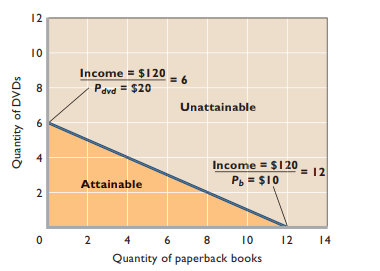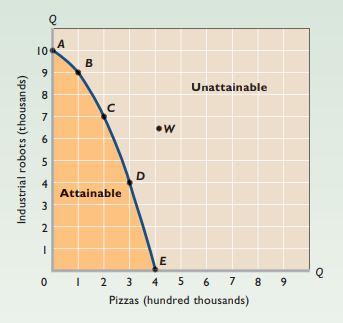
Chapter 1: Limits, Alternatives, and Choices
Unlimited wants, scarce resources
Economics - Social science of how individuals, institutions, + society make choices under scarcity
Opportunity cost - Value of the good, service, or time forgone to obtain something else
“There is no free lunch”
Economic perspective - Economic way of thinking
Utility - Pleasure/happiness/satisfaction from consuming good/service
Purposeful behavior - People make decisions w/ desired outcomes in mind
Consumers + institutions make rational decisions by comparing marginal costs + marginal benefits
Marginal analysis - Comparisons of marginal benefits + marginal costs for decision making
Economists use the scientific method -- Form + test hypotheses of cause & effect relationships → Generate theories, laws, + principles
Economic principle - Widely-accepted theory; statement about economic behavior that allows for predictions of effects of certain actions
Combine theories into representations called models
Economic principles are generalizations
Other-things-equal assumption - Assumption that factors other than those being considered do not change
Microeconomics - Concerned w/ individual units (person, household, firm, industry)
Observes details of small part of economy
“The sand and shells”
Macroeconomics - Examines either the entire economy or basic aggregates (gov’t, business sectors)
Aggregate - Collection of specific economic units treated as 1 unit
General overview of economy + relationships of major aggregates
“The beach”
Positive economics - Facts + cause-and-effect relationships
Avoids value judgements
Scientific statements
“What is”
Normative economics - Value judgements about what the economy SHOULD be like
Desirability of certain parts of the economy
Expresses support for certain economic policies
“What should be”
Economizing problem - Need to make choices because economic wants exceed economic means
Unlimited desires, limited income
Budget line - Schedule or curve that shows various combos of 2 products that can be purchased with specific money income
Inside budget line = Attainable
Outside budget line = Unattainable

Trade-offs - Must give something up to get something else
Choice - Choose what to buy + what to forgo
Income changes - Budget line shifts w/ changes in income
Economic resources - All natural, human, manufactured resources used for production of goods and services
Land - All natural resources
Labor - Physical + mental talents of individuals used in production
Capital - All manufactured aids used in production (ex. tools, machinery, etc.)
Entrepreneurial ability - Strategic business decisions, innovation, strategically combining resources, etc.
Production possibilities model
Consumer goods - Products that satisfy wants directly
Capital goods - Products that satisfy wants indirectly
Production possibilities curve - Graph that shows different combos of goods + services that can be produced in fully employed economy
Assumes resource quantity, resource quality, and technology are fixed
Shows limit of attainable outputs
Bowed out from origin

Law of increasing opportunity costs - As production of a good increases → Opportunity cost of producing an additional unit rises
Gain of one type of good or service → Always accompanied by loss of one type of another good or service
Resources not equally adaptable to different uses → Shifting resources from one use to another → Increasing opportunity costs
Optimal allocation where Marginal Benefit = Marginal Cost (MB = MC)
Most desirable mix of goods
Unemployment represented by point inside original production possibilities curve
Economic growth - Growth of economic capacity; larger total output
Increased resource supplies
Advances in technology
More focus on capital goods over consumer goods → Production possibilities curve further to the right
International specialization + trade → Economy can consume MORE than production possibilities curve
International specialization - Directing resources at output that nation is efficient in producing
International trade - Exchange of goods for goods produced abroad
Chapter 1: Limits, Alternatives, and Choices
Unlimited wants, scarce resources
Economics - Social science of how individuals, institutions, + society make choices under scarcity
Opportunity cost - Value of the good, service, or time forgone to obtain something else
“There is no free lunch”
Economic perspective - Economic way of thinking
Utility - Pleasure/happiness/satisfaction from consuming good/service
Purposeful behavior - People make decisions w/ desired outcomes in mind
Consumers + institutions make rational decisions by comparing marginal costs + marginal benefits
Marginal analysis - Comparisons of marginal benefits + marginal costs for decision making
Economists use the scientific method -- Form + test hypotheses of cause & effect relationships → Generate theories, laws, + principles
Economic principle - Widely-accepted theory; statement about economic behavior that allows for predictions of effects of certain actions
Combine theories into representations called models
Economic principles are generalizations
Other-things-equal assumption - Assumption that factors other than those being considered do not change
Microeconomics - Concerned w/ individual units (person, household, firm, industry)
Observes details of small part of economy
“The sand and shells”
Macroeconomics - Examines either the entire economy or basic aggregates (gov’t, business sectors)
Aggregate - Collection of specific economic units treated as 1 unit
General overview of economy + relationships of major aggregates
“The beach”
Positive economics - Facts + cause-and-effect relationships
Avoids value judgements
Scientific statements
“What is”
Normative economics - Value judgements about what the economy SHOULD be like
Desirability of certain parts of the economy
Expresses support for certain economic policies
“What should be”
Economizing problem - Need to make choices because economic wants exceed economic means
Unlimited desires, limited income
Budget line - Schedule or curve that shows various combos of 2 products that can be purchased with specific money income
Inside budget line = Attainable
Outside budget line = Unattainable

Trade-offs - Must give something up to get something else
Choice - Choose what to buy + what to forgo
Income changes - Budget line shifts w/ changes in income
Economic resources - All natural, human, manufactured resources used for production of goods and services
Land - All natural resources
Labor - Physical + mental talents of individuals used in production
Capital - All manufactured aids used in production (ex. tools, machinery, etc.)
Entrepreneurial ability - Strategic business decisions, innovation, strategically combining resources, etc.
Production possibilities model
Consumer goods - Products that satisfy wants directly
Capital goods - Products that satisfy wants indirectly
Production possibilities curve - Graph that shows different combos of goods + services that can be produced in fully employed economy
Assumes resource quantity, resource quality, and technology are fixed
Shows limit of attainable outputs
Bowed out from origin

Law of increasing opportunity costs - As production of a good increases → Opportunity cost of producing an additional unit rises
Gain of one type of good or service → Always accompanied by loss of one type of another good or service
Resources not equally adaptable to different uses → Shifting resources from one use to another → Increasing opportunity costs
Optimal allocation where Marginal Benefit = Marginal Cost (MB = MC)
Most desirable mix of goods
Unemployment represented by point inside original production possibilities curve
Economic growth - Growth of economic capacity; larger total output
Increased resource supplies
Advances in technology
More focus on capital goods over consumer goods → Production possibilities curve further to the right
International specialization + trade → Economy can consume MORE than production possibilities curve
International specialization - Directing resources at output that nation is efficient in producing
International trade - Exchange of goods for goods produced abroad
 Knowt
Knowt